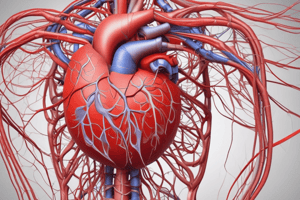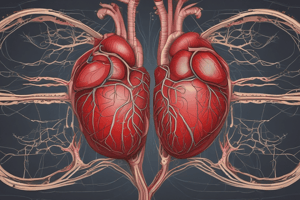Podcast
Questions and Answers
Which of the following accurately describes the purpose of a cardiovascular study guide's 'Definition/Identification' section?
Which of the following accurately describes the purpose of a cardiovascular study guide's 'Definition/Identification' section?
- To enable learners to define key terms and identify anatomical structures. (correct)
- To provide a detailed history of cardiovascular research milestones.
- To compare and contrast different cardiovascular diseases based on incidence rates.
- To outline the future directions of cardiovascular medicine.
The 'Definition/Identification' section in a cardiovascular study guide solely focuses on defining terms without any reference to anatomical structures.
The 'Definition/Identification' section in a cardiovascular study guide solely focuses on defining terms without any reference to anatomical structures.
False (B)
In the context of a cardiovascular study guide, what is the dual purpose of the 'Definition/Identification' section?
In the context of a cardiovascular study guide, what is the dual purpose of the 'Definition/Identification' section?
to define key terms and identify anatomical structures
The 'Definition/Identification' section requires students to be able to _______ terms and locate structures on a ______.
The 'Definition/Identification' section requires students to be able to _______ terms and locate structures on a ______.
Match the following study guide aspects with their descriptions:
Match the following study guide aspects with their descriptions:
Which statement accurately compares cardiac muscle to skeletal muscle?
Which statement accurately compares cardiac muscle to skeletal muscle?
The sinoatrial (SA) node reaches threshold spontaneously due to a constant influx of sodium ions, leading to a gradual depolarization.
The sinoatrial (SA) node reaches threshold spontaneously due to a constant influx of sodium ions, leading to a gradual depolarization.
Why is ventricular fibrillation more dangerous than atrial fibrillation?
Why is ventricular fibrillation more dangerous than atrial fibrillation?
The ______ carries deoxygenated blood from the heart to the lungs.
The ______ carries deoxygenated blood from the heart to the lungs.
Match the ECG wave/interval with the corresponding electrical event in the heart:
Match the ECG wave/interval with the corresponding electrical event in the heart:
Which of the following is a characteristic of cardiac muscle that allows the heart to function as a coordinated pump?
Which of the following is a characteristic of cardiac muscle that allows the heart to function as a coordinated pump?
The fibrous pericardium is the layer directly adhered to the surface of the heart.
The fibrous pericardium is the layer directly adhered to the surface of the heart.
What is the primary function of the atrioventricular (AV) valves within the heart?
What is the primary function of the atrioventricular (AV) valves within the heart?
The sinoatrial (SA) node is known as the heart's natural ________ because it initiates the electrical impulses that drive the cardiac cycle.
The sinoatrial (SA) node is known as the heart's natural ________ because it initiates the electrical impulses that drive the cardiac cycle.
Match each component of the cardiac conduction system (CCS) with its function:
Match each component of the cardiac conduction system (CCS) with its function:
Which of the following best describes the sequence of blood flow through the heart?
Which of the following best describes the sequence of blood flow through the heart?
Tachycardia always indicates a life-threatening condition.
Tachycardia always indicates a life-threatening condition.
What is the relationship between diastole and systole in the cardiac cycle, and how do they affect blood flow?
What is the relationship between diastole and systole in the cardiac cycle, and how do they affect blood flow?
Which of the following best describes the primary advantage of a closed circulatory system compared to an open circulatory system?
Which of the following best describes the primary advantage of a closed circulatory system compared to an open circulatory system?
Arteries have thicker walls than veins primarily to withstand the higher blood pressure generated by the heart.
Arteries have thicker walls than veins primarily to withstand the higher blood pressure generated by the heart.
Describe how skeletal muscle contractions aid in venous return, and explain why this mechanism is less effective in the absence of valves.
Describe how skeletal muscle contractions aid in venous return, and explain why this mechanism is less effective in the absence of valves.
An increase in blood viscosity will lead to a(n) _______ in peripheral resistance, assuming other factors remain constant.
An increase in blood viscosity will lead to a(n) _______ in peripheral resistance, assuming other factors remain constant.
Match the capillary type with its typical location and structural feature:
Match the capillary type with its typical location and structural feature:
Which of the following factors does not directly influence peripheral resistance?
Which of the following factors does not directly influence peripheral resistance?
Vasoconstriction decreases blood pressure by increasing the diameter of blood vessels.
Vasoconstriction decreases blood pressure by increasing the diameter of blood vessels.
What is the primary role of baroreceptors in blood pressure regulation?
What is the primary role of baroreceptors in blood pressure regulation?
The mean arterial pressure (MAP) can be calculated using the formula: MAP = ______ + (Diastolic Pressure / 3).
The mean arterial pressure (MAP) can be calculated using the formula: MAP = ______ + (Diastolic Pressure / 3).
Match each capillary type with its structural characteristic:
Match each capillary type with its structural characteristic:
Which layer of a blood vessel is primarily responsible for vasoconstriction and vasodilation?
Which layer of a blood vessel is primarily responsible for vasoconstriction and vasodilation?
Arteries typically have thinner walls and larger lumens compared to veins.
Arteries typically have thinner walls and larger lumens compared to veins.
What two primary mechanisms are used to alter blood pressure in the body?
What two primary mechanisms are used to alter blood pressure in the body?
Cardiac output (CO) is calculated by multiplying ______ by stroke volume (SV).
Cardiac output (CO) is calculated by multiplying ______ by stroke volume (SV).
Which of the following best describes the role of albumin in systemic circulation?
Which of the following best describes the role of albumin in systemic circulation?
Flashcards
Heart
Heart
The central pump of the circulatory system, responsible for propelling blood throughout the body.
Artery
Artery
A vessel that carries blood away from the heart to the body's tissues.
Vein
Vein
A vessel that carries blood towards the heart from the body's tissues.
Capillary
Capillary
Signup and view all the flashcards
Pulmonary Circulation
Pulmonary Circulation
Signup and view all the flashcards
Epicardium
Epicardium
Signup and view all the flashcards
Myocardium
Myocardium
Signup and view all the flashcards
Endocardium
Endocardium
Signup and view all the flashcards
SA Node
SA Node
Signup and view all the flashcards
AV Node
AV Node
Signup and view all the flashcards
Tachycardia
Tachycardia
Signup and view all the flashcards
Diastole
Diastole
Signup and view all the flashcards
Systole
Systole
Signup and view all the flashcards
Closed Circulatory System
Closed Circulatory System
Signup and view all the flashcards
Blood Vessel Wall Layers
Blood Vessel Wall Layers
Signup and view all the flashcards
Arterial Baroreceptors
Arterial Baroreceptors
Signup and view all the flashcards
Capillary Structure
Capillary Structure
Signup and view all the flashcards
Hydrostatic vs. Osmotic Pressure
Hydrostatic vs. Osmotic Pressure
Signup and view all the flashcards
Pulmonary artery vs. vein
Pulmonary artery vs. vein
Signup and view all the flashcards
Cardiac muscle syncytium
Cardiac muscle syncytium
Signup and view all the flashcards
SA node spontaneous firing
SA node spontaneous firing
Signup and view all the flashcards
Purpose of the CCS
Purpose of the CCS
Signup and view all the flashcards
Apex contraction first
Apex contraction first
Signup and view all the flashcards
Systolic Pressure
Systolic Pressure
Signup and view all the flashcards
Diastolic Pressure
Diastolic Pressure
Signup and view all the flashcards
Hemodynamics
Hemodynamics
Signup and view all the flashcards
Arterioles
Arterioles
Signup and view all the flashcards
Anastomosis
Anastomosis
Signup and view all the flashcards
Vasoconstriction
Vasoconstriction
Signup and view all the flashcards
Vasodilation
Vasodilation
Signup and view all the flashcards
Cardiovascular (CV) Center
Cardiovascular (CV) Center
Signup and view all the flashcards
Vasomotor Center
Vasomotor Center
Signup and view all the flashcards
Baroreceptors
Baroreceptors
Signup and view all the flashcards





